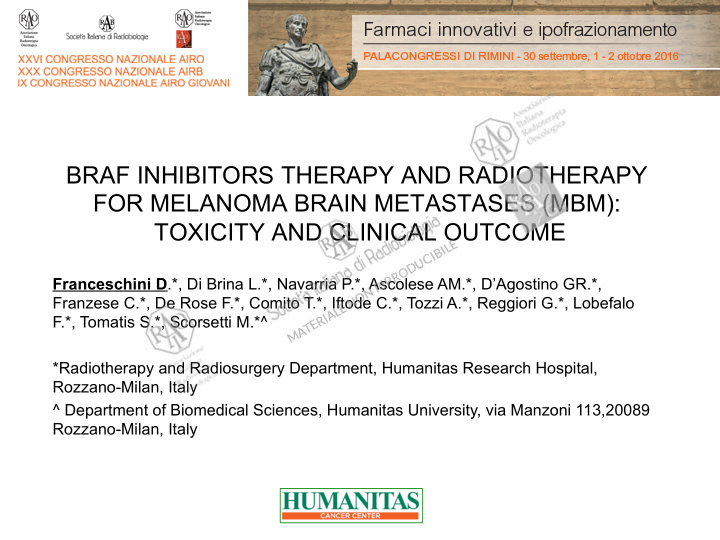



BRAF INHIBITORS THERAPY AND RADIOTHERAPY FOR MELANOMA BRAIN METASTASES (MBM): TOXICITY AND CLINICAL OUTCOME Franceschini D .*, Di Brina L.*, Navarria P.*, Ascolese AM.*, D’Agostino GR.*, Franzese C.*, De Rose F.*, Comito T.*, Iftode C.*, Tozzi A.*, Reggiori G.*, Lobefalo F.*, Tomatis S.*, Scorsetti M.*^ *Radiotherapy and Radiosurgery Department, Humanitas Research Hospital, Rozzano-Milan, Italy ^ Department of Biomedical Sciences, Humanitas University, via Manzoni 113,20089 Rozzano-Milan, Italy
2014
2015
2012 In conclusion, dabrafenib is the first drug of its class to show activity in treatment of melanoma brain metastases.
2012 Dabrafenib has activity and an acceptable safety profile in patients with Val600Glu BRAF- mutant melanoma and brain metastases irrespective of whether they are untreated or have been previously treated but have progressed.
2011 Treatment of B-Raf+ cells with the B-RAF inhibitor PLX-4032 in combination with radiation provided enhanced inhibition of both colony formation and invasion, and radiosensitized cells through an increase in G1 arrest. Conclusions: Our data suggest that melanomas are not uniformly radioresistant with a significant subset displaying inherent radiosensitivity. Pharmacologic inhibition of B-RAF with PLX-4032 effectively radiosensitized B-Raf+ melanoma cells suggesting that this combination approach could provide improved radiotherapeutic response in B-Raf+ melanoma patients.
2013
2013
Humanitas experience
Patient’s demographics and treatment characteristics Parameter Number of cases (frequency) Number of pa,ents 16 Number of lesions Single: 6 (37.5%) Two: 5 (31.25%) Mul,ple 5 (31.25%) Median age (range) [years] 53 [29-81] Sex Male/Female 9 (56%) / 7 (44%) Performance status 0 12 (75%) 1 2 (12.5%) 2 2 (12.5%) Extracranial disease Yes 8 (50%) No 8 (50%) Systemic therapy Vemurafenib 7 (43%) Dabrafenib + Trametinib 9 (57%) RT type RS 10 (62.5%) WBRT 6 (37.5%)
Local control and distant failure Status Number of cases (frequency) Complete response 1 (6.25%) Par,al Response 10 (62.5%) Stable disease 3 (18.75%) Progressive disease 2 (12.5%) Mean Time to progression [range] (months) 7,5 ( range 1.6-14.2) Intracranial progression 11 (68.75%) Time to intracranial progression [range] (months) 7.6 (range 1.6-14.2) Extracranial progression 3 (18.75%) Time to extracranial progression [range] (months) 5.4 (range 4.5-6.7)
Local control and distant failure OS 6 87% LC 6 87,5% IDDC 6 61,9% 12 52,4% 12 87.5%. 12 21,7%
Toxicity • RADIATION NECROSIS 2 • BLEEDING 1 • SKIN TOXICITY 0
2015
Thanks for your attention! … again
Recommend
More recommend